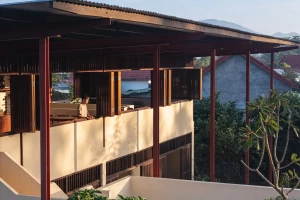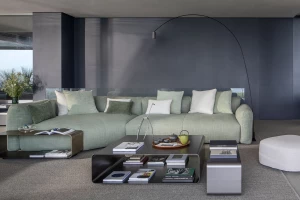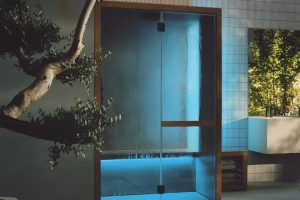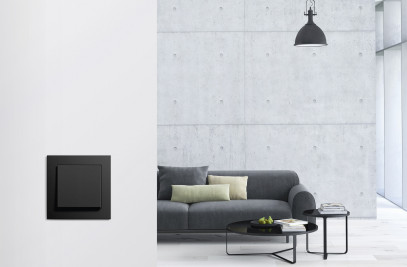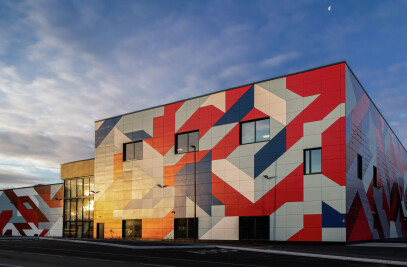At the La Raia Estate in Gavi, Italy, De Amicis Architetti has restored and reimagined spaces within a traditional Italian farmstead estate, transforming it into an event and hospitality space specifically to host art events. Called the Borgo Merlassino event and hospitality venue, the project features expansive courtyards and open galleries that can accommodate both indoor and outdoor exhibitions. The project demonstrates that modern architecture does not have to be at odds with nature or tradition but can, instead, enhance the qualities of a place and create a harmonious relationship between human activity and the environment.
Borgo Merlassino is located on the 180-hectare La Raia estate, once used for a variety of agricultural activities in the 19th century. The story of the restoration and transformation of Borgo Merlassino begins with an account of the existing barn, stable, pigsty, henhouse, storage, cistern, manure pit, courtyard, canopy, and agricultural residences. These spaces and functions of the agricultural complex were in an advanced state of decay. Some were entirely invisible, buried, or overgrown with vegetation.
The first step in the project was to investigate the site's potential by reading between the existing structures to identify the best values and restore a clear relationship with the landscape. It quickly became clear from this exercise that the key to rediscovering the essence of the 'place' was not so much in the buildings themselves but rather the character and quality of the spaces between them – spaces that the design studio focused on in particular.
By designating specific spaces to particular functions and designing new types of open spaces - such as the terraces, portico, lawn and courtyard – all the existing volumes were logically interconnected, resulting in a new configuration resembling a Borgo (hence the name), with rich diverse and usable open spaces for various activities.
The resulting Borgo Merlassino comprises the Barn, which is the main structure, the Villa and the Farmhouse, the Patio, and the Porch. Each of these includes two rooms for overnighting and covered outdoor spaces. The complex also includes a Studio and Warehouse. Each original structure was once used for agricultural activities in the 19th century.
During the restoration process, elements of the original building, such as exposed beams, typical portholes, and a Pise Wall, an ancient raw-earth construction technique, were uncovered and maintained to retain the setting's original charm. Large windows were installed to take advantage of natural lighting, optimize views of the estate, and reinforce the synergy between indoor and outdoor spaces.
The main building of Borgo Merlassino, once a large barn, can now accommodate up to 120 guests over three floors structured for modular hosting. The modular nature allows the possibility of throwing several events at the same time or utilizing each space for a different part of an event—e.g., ceremony, dinner, or prep space.
The Patio, a large outdoor space, connects the Barn and the Farmhouse. Suitable for reception and cocktails, it is adorned with a ceiling decorated in colourful geometric patterns and a backdrop for wooden slats. It can easily become an open-air lounge for dinner dinners. Once a chicken coup, an additional dedicated structure stands separate for receptions.
Throughout the restoration process, it became clear that a position needed to be taken on how the new elements would interact with the existing structures. Each case and situation was evaluated individually. The proposed volumetric additions, necessary for expanding functions and rethinking the distribution system, sometimes manifest with bold material contrasts – such as the new iron lozenge-patterned ceiling, which enrich the repertoire of architectural and formal solutions. In other cases, such as the new openings in the pigsty, interventions integrate naturally into the existing structure.
Façades feature plastered surfaces, with different colours applied to various buildings according to their functions and varying textures to enhance the architectural composition. Some sections of existing earth-built walls have been left exposed, showcasing the traditional construction techniques of the area.
Window frames are made of painted wood with varied opening shapes – square, arched, or circular – stemming from the original design and a careful composition and study of the facades. Roofs are covered with terracotta tiles a material used widely in the region. Some areas include photovoltaic panels.
In addition to large green areas, including lawns and planted zones, there are gravel areas, coloured concrete pavements, wooden block paving, and reclaimed railway sleepers used in various ways to separate different materials or highlight the layout of the outdoor spaces.
Inside, various finishing materials have been used, depending o the intended use of the spaces. The construction phases (work was carried out at different times) and the interior design project. Floors include decorative cement tiles, solid oak parquet laid in a micro-herringbone pattern, polished slate slabs, split slate strips laid in a herringbone pattern, cocciopasto ( a traditional material made from crushed terracotta and lime) and solid Carrara marble shower trays. Notable finishes include a green-coloured and polished concrete lift shaft (with exposed aggregates), stair treads made from solid larch (reclaimed from old roof beams), custom-designed metal railings, and ceramic tiles.
Colour is used throughout the project in various ways. In some instances, colours are inherent to the materials used, mostly natural (i.e. slate, Luserna stone, various types of wood, gravel, clay, terracotta). In other cases, neutral materials have been given a distinctive character with colour, such as concrete pigmented with different natural oxides (orange for the exterior pavements, green for the internal staircase/lift shaft). Additionally, vivid purple and yellow highlight the lozenge-patterned ceiling and the plastered sections of the external facades, where the neutral tones of the main buildings are contrasted with dark sections and the vibrant red of the secondary structures.
De Amicis Architetti's work on La Raia Estate is, in summary, a fine example of architecture that responds to the demands of modern sustainability while respecting the deep-rooted traditions of its setting.


















